BANDHANI バンダニ
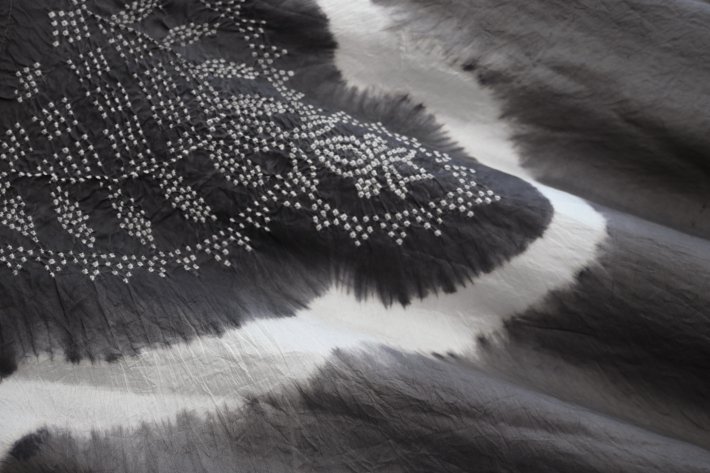
バンダニとは About Bandhani
染め残す部分を糸で括る、「括り絞り」の布や技法です。「括り絞り」は、世界中に伝わる、布の一部を巻く、挟む、縫うなどの防染により文様を作る「絞り染め」の技法の一種です。
名称はサンスクリット語のbandh(結ぶ・縛る)に由来し、バンデジ(Bandhej)とも。日本の鹿の子絞りや疋田絞りと似た技法で、小さくつまんだ布の一部を糸できつく括った状態で染め、糸をほどくと括った部分が染め残されて点模様(ドット)になります。
It is a resist dye technique by tying, leaving a space undyed and creating designs and patterns. The cloth using this technique is also regarded as Bandhani. Tying is one of multiple tie-dye techniques including wrapping, clamping, and stitching which have been practiced over the world.
The name is derived from the Sanskrit word 'Bandh' (to tie or bind) and is also called 'Bandhej'. Its technique is similar to the Japanese tie-dye, such as Kanoko Shibori and Hitta Shibori, in which a small part of the cloth is pinched and tied tightly with the thread, dyed, and when the thread is open, the tied parts become undyed creating a dot pattern.
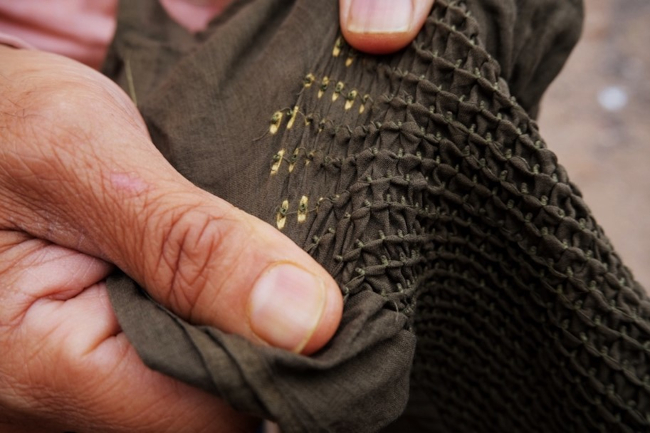
Opening of knots by pulling fabrics… at SIDR Craft, 2019
バンダニの産地 Production Area of Bandhani
インド西部のグジャラート州やラージャスターン州が主な産地です。この二州には、古くからバンダニの産地として知られるパキスタンのシンド州から多くの人々が移り住んだといわれます。グジャラート州では、サウラーシュトラ地方のジャームナガールやポルバンダール、カッチ地方のブージ、アンジャール、マンドヴィ、アブダサやアーメダバード近郊、ラージャスターン州では、ジャイプール、ビカネール、ジョドプール、バールメール、ナスドワラなどが有名です。
インド国内ではほかにマディヤ・プラデーシュ州、タミル・ナードゥ州、カルナタカ州、アッサム州、西ベンガル州などでもバンダニが作られています。地域やコミュニティによって、様々な種類のアイテムやデザインがありますが、その技法はほぼ共通しています。グジャラート州のサウラーシュトラの人々が移り住んで伝えられたという、タミル・ナードゥ州マドゥライの絞り染めはスンガディ(Sungadi)と呼ばれています。
Gujarat and Rajasthan in Western India are the major production areas. To these two states, many people have immigrated from the Sindh state of Pakistan where has been known as a production center of Bandhani for the long time. In Gujarat, Jamnagar, Porbandar in Saurashtra, Bhuj, Anjar, Mandvi and Abdasa in Kutch, also outskirts of Ahmedabad are known as production centers, while in Rajasthan, Jaipur, Bikaner, Jodhpur, Barmer and Nathdwara are.
It also has been practiced in other parts of India such as Madhya Pradesh, Tamil Nadu, Karnataka, Assam and West Bengal.
Those items and designs differ by the regions and the communities, the general techniques are almost the same. The tie-dye of Madurai in Tamil Nadu is called 'Sungadi', which is said to have been introduced by the Saurashtra people of Gujarat.
バンダニの歴史 History of Bandhani
起源は定かではありませんが、絵画や文献に残された記録から、その歴史の長さをうかがい知ることができます。
例えば、7世紀頃までに描かれたアジャンター石窟群(西インドのマハラーシュトラ州)の壁画には、侍女がバンダニらしき文様の布を纏っています。
主要産地であるグジャラートのバンダニは、12世紀にムルタン(現在のパキスタン・パンジャーブ州ムルタン)やシンドから移住してきたコミュニティによりもたらされたとされています。18世紀にはイギリスの東インド会社を通じたヨーロッパ向けの交易品として注目され、グジャラート州カッチのほかジャムナガールやムンバイでも生産されるようになりました。またベンガルからは18〜19世紀初頭に絞り染めを施したシルクのハンカチがロンドンへ、また西インド諸島や東アフリカなどにあるイギリスの植民地へと輸出され、それが「バンダナ」の語源になりました。
バンダニは、輸出品としてだけでなく、各産地の周辺地域を中心に、晴れ着から普段着まで、あるいは生活の布として、人びとの暮らしに根づき、利用され続けてきました。元々染色にはそれぞれの土地の天然素材が用いられていましたが、安価で効率のよい化学染料が導入されるとそれらへの移行が進み、しだいに伝統的な染色に関する知識は失われていきました。その一方で、ほんの一握りですが、天然染料を用いた染めを復元する職人もいます。
The origin of Bandhani still has been uncertain though, we will imagine its long journey from the records left in the paintings and the literatures. For instance, the pattern that resembles Bandhani can be seen on the blouse of a maid in the murals of the cave temples of Ajanta (Maharashtra, Western India) which is considered painted by the 7th century.
In Gujarat, one of the main production areas of Bandhani today, is said to have been introduced in the 12th century by the communities who immigrated from Multan (present-day Multan, Punjab in Pakistan) and Sindh. In the 18th century, it attracted attention as a trade item for Europe through the British East India Company, and around this time it began to be produced in Kutch, Gujarat, as well as Jamnagar and Mumbai. In the 18th and early 19th centuries, tie-dyed silk handkerchiefs from Bengal were exported to London and then to British colonies in the West Indies and East Africa, which is where the word "bandana" comes from.
Bandhani has been used not only as an export item, but also in people's daily lives, mainly in the surrounding areas of each region where it is produced, from formal wear to everyday wear, also as a cloth for the daily life. Originally, natural materials which were available locally have been used for dyeing, but with the introduction of cheap and efficient chemical dyes, this practice has been changed. People has lost their knowledge of traditional dyeing gradually. However, there are artisans, still only a few though, who revive dyeing techniques using natural dyes.
バンダニを手がける人びと People engaging in Bandhani
インドの手仕事の多くがそうであるように、バンダニも特定のコミュニティのなかで家業として受け継がれています。一般的に括り作業は女性、生地の洗いや染色は男性と分業されてきました。括り作業をする人はバンダナラ(bandhanara)と呼ばれ、その多くの作業は特別な工房の中ではなく、各家庭やその軒先で行われます。女性たちは結婚前から括りの技術を身につけ、子育てや家事の合間の自由な時間に作業をします。またバンダニには下絵の輪郭に沿ってドットを作るサルカム(sarkam)と輪郭の内側をドットで埋めるバールティ(bharti)がありますが、より括りの数が多く、緻密な作業が必要になるバールティを専門とする括り職人もいます。
Like many handicrafts in India, Bandhani is a family business that is passed down within specific communities, such as Khatris in Kutch. Generally tying work was done by women, and washing and dyeing of fabrics were done by men. The craftsperson who engages in the tying work is called a 'bandhanara', and most of their works are not done in a special workshop, but at their own houses or cottages. Women learn the art of tying even before marriage, and work on it in their free time between caring children and doing housework.
There is also a craftsperson who specialize in 'Bharti', which fills the inside of the outline with dots that require precise work, while 'Sarkam' creates dots along the outline of the sketch.
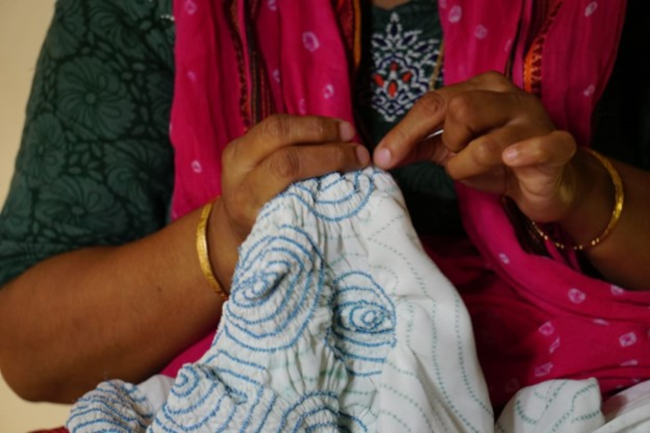
In Ajrakhpur, Kutch. There are Khatri ladies engage in Bandhani works, while all the men at work making Ajrakh outside. 2019
バンダニをまとう人びと People wearing Bandhani
バンダニには地域・コミュニティにより、それぞれ定番のアイテムやデザイン、色、素材があります。ひとびとはバンダニを纏うことで、自分の属性だけでなく個性も表現してきました。バンダニはサリーやオダニ(Odhani/ショール、ベール)など大きな長方形の形態で用いられることが多いのですが、アバ(ドレス)やチョリ(ブラウス)、ガーグラー(スカート)に使うコミュニティもあります。一方で“バンダニ風”の安価なプリント生地が出回り、日常的にはそちらを目にすることのほうが多いですが、伝統的な定番アイテムとそれをまとう人びともまだまだ健在です。ここでは各地の代表的なバンダニのアイテムを紹介します。
As Bandhani, there are typical items, designs, colors, and materials depending on the region or the community. These are also things that help the person who wear them express their attributes and uniqueness.
Bandhani commonly has been used in the form of large rectangles such as sarees or 'Odhani' (shawls and veils), but also been used as 'Abha' (dress), 'Choli' (blouse) and 'Ghagra' (skirt).
Machine printed fabrics taking design ideas by Bandhani are more available and common in the market also in the daily lives though, traditional items and the people who wear those are still alive and well. Here we will introduce typical Bandhani items from each region.
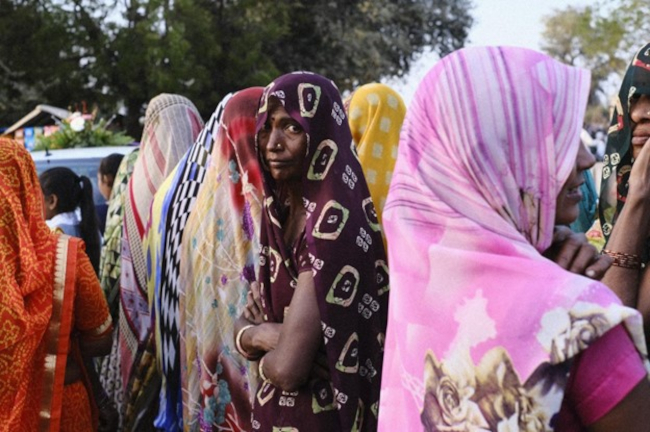
Ladies who wear Odhanis with Bandhani like designs. In Gandhinagar, Gujarat. Photo by Yayoi Arimoto. 2019
今回はグジャラートのバンダニを特集してご紹介します。(ラージャスターン篇に続く予定です)
We are featuring Bandhani from Gujarat this time. (Rajasthan chapter will be followed later.)
ガルチョーラー Gharchola
元々は「家着」という意味の、グジャラート州サウラシュトラの王族や商人が纏っていたサリーでした。現在ではおもにヒンドゥー教徒とジャイナ教徒の花嫁がまとう特別な赤いオダニとして作られています。素材は薄いコットンやシルクで、金や銀のザリ(金属糸)を織り込んで全体をマス目状に区画し、区画の内側を白や黄色の絞り文様で埋めたデザインが特徴です。
Originally it meant 'home clothes' and has been made as red Odhani for the brides. It also arranged as sarees to be worn by ladies of the ruler or merchant families in Saurashtra in Gujarat.
Generally, it is made of thin cotton or silk, and gold or silver zari (metal thread) are woven into sections, dividing the whole into squares, and the inside of the sections is filled with white or yellow Bandhani patterns.
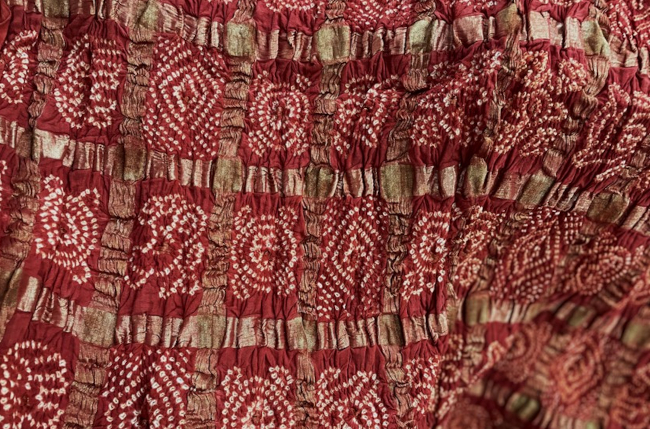
Gharchola Saree with madder dye. One of the latest works of SIDR Craft. Jan 2023
コンビー Khombi
カトリーやメーモンなどのイスラム教徒のコミュニティの花嫁がまとうオダニ。伝統的なものは、赤や黒の生地に白のドットで植物柄などの絞り染めが施されています。
Odhani worn by brides from Muslim communities such as Khatris, Memons etc. Traditionally it is dyed into either red or black, with botanical Bandhani designs of white dots patterns.
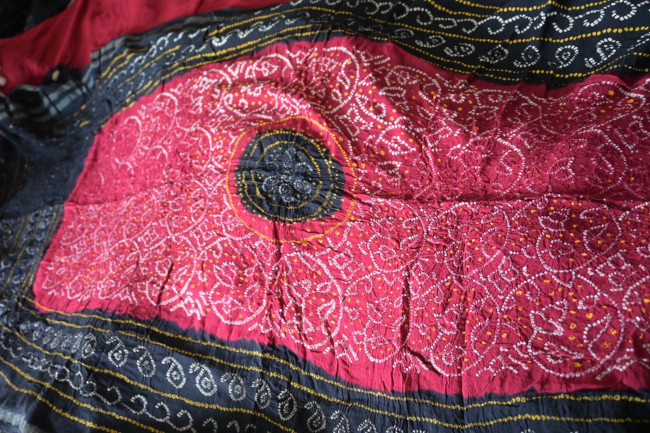
A Khombi of Memon Community called as “Shikari”. Aug, 2023
チャンドロカニ Chandrokhani
イスラム教徒の義母から花嫁に贈呈される黒と赤のオダニ。デザインには人物モチーフが使われず、「月のような」という意味の名前の通り中心に月のようなメダリオンが配置されるのが特徴です。普段着としても使われます。
A black and red Odhani given to a Muslim bride by her mother-in-law. Chandrokhani never had human motifs, and as the name suggests, it is characterized by a moon-like medallion placed in the center. It is also used as everyday wear.
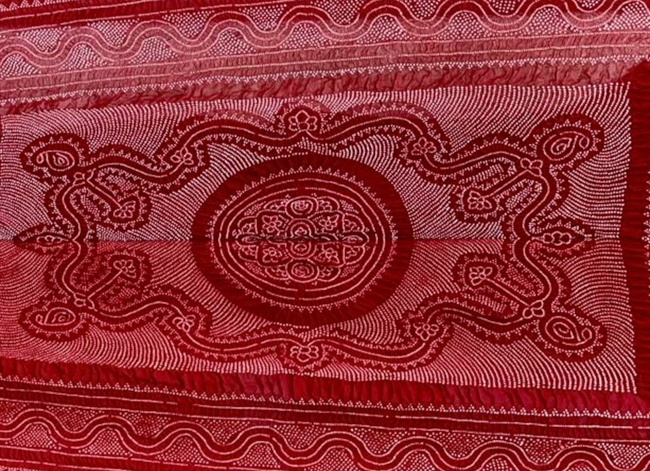
ルディ Ludi
牧畜民であるラバーリーの女性が日常的にまとうウールのオダニ。彼女らが暮らす乾燥地域の強い日差しや砂ぼこりから、そして寒さからも身を守る役割を果たしてきました。結婚し、第一子を出産するまでは黒ベースに黄色または錆色でドットをあしらったスハガディ、第一子出産後は黒ベースに赤のドットをあしらったサトバティリ、やがて未亡人になると黒い無地のジミと、デザインが女性のライフステージを表しています。
A woolen Odhani worn daily by Rabari women, who are pastoralists. It has played a role in protecting them from the strong sunlight and dust of the arid regions where they live, as well as from the cold. Those designs represent the life stages of a woman, such as Suhagadi, a black base with yellow or rust-colored dots, is worn until the marriage and the birth of the first child, also Satbhatili, a black base with red dots, is for after the birth of the first child, then Jimi, a plain black, is for the time she becomes a widow eventually.
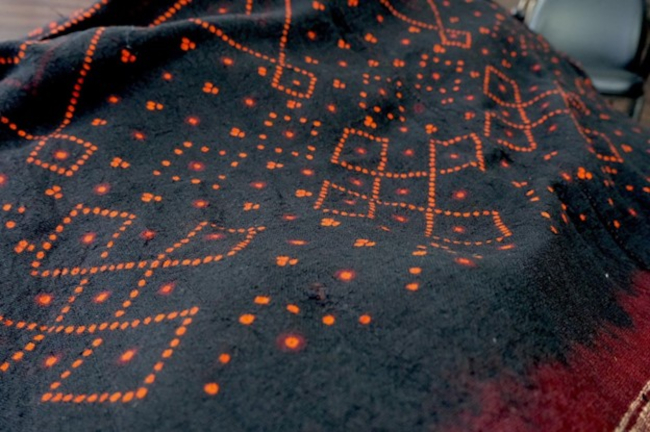
Ludi of Kutch Rabari. Suhagadi with orange dots. Aug 2023
メーグワールのオダニ Odhani of Meghwar
ヴァンカル(織り師)コミュニティのメーグワールの女性が纏うオダニ。ヴァンカルが織った布をカトリーが染めて仕上げられる。赤やオレンジのボディに、黒く大きなボーダーや中央の円が特徴。
Odhani worn by ladies of Meghwad, which is known as Vankar (=weaver)'s community. They weave it by themselves and get it tie-dyed by Khatris. Typically, it consists of red or orange body with both the bold border and the center circle in black.

工程 Process
- 生地の前処理 Fabric pretreatment
- 下絵つけ Underpainting
- 括り Tying
- 染め Dyeing
- 乾燥・仕上げ Drying and finishing
生地を洗って糊を抜き、不純物を取り除く。生地全体を下染めすることもある。デザインや厚さに応じて、生地を2回、または4回折りたたみ、縁に沿って軽く縫い合わせて固定する。
Wash the fabric to remove starch and impurities. Sometimes the entire fabric has been pre-dyed. Depending on the design and thickness, fold the fabric two or four times and secure by lightly stitching along the edges.
かつては「ゲル(geru/水で溶いたベンガラ)に浸した木版でプリントしていたが、現在ではワックスペーパーに染料液で模様を手描きし、それを生地に重ねて上から針で刺すことで転写することが多い。
In the past, printing was done with a woodblock soaked in gel (geru), but now designs are hand-painted on wax paper with a dye solution. It is often transferred by layering it on the fabric and pricking it from above with a needle.
多くの場合、女性たちが下絵の線に沿って細かく生地を括っていく。小指の爪や先のとがった指輪で生地の一部を引き上げ、その先に「デリ」と呼ばれる丈夫なコットン糸を巻きつける。この動作を、ボビンとして使われる「ブンガリ(ガラス管)」と「ナクロ(指ぬき)」に巻いたデリを引き出しながら必要なドットの数だけ途方もない回数くり返す。ひとつのドットは「ビンディ(bindi)」と呼ばれ、それらには、基本的なドットの「アニワリ・ベーンティ」と、細かい円からなる「マタワリ・ベーンディ」がある。
また、ラジャスターンのバンダニは、ダビ(dabbi/小さな箱という意味)と呼ばれる四角いドットを特徴とする。
In most cases, the women tie the fabric in detail along the lines of the sketch. They pull up a part of the fabric using their little fingernail or a pointed ring, and then wrap a strong cotton thread called 'deli' around the tip. Using 'Bungari (glass tube)' and 'Nakuro (thimble)' as bobbins, this action is repeated numerous times around the deli. The single dot is called a 'Bindi', and there are two types: the basic dot 'Aniwali Behndi' and the fine circle 'Matawali Behndi'. The Rajasthani Bandhani is also characterized by square dots called Dabbi (meaning small box).
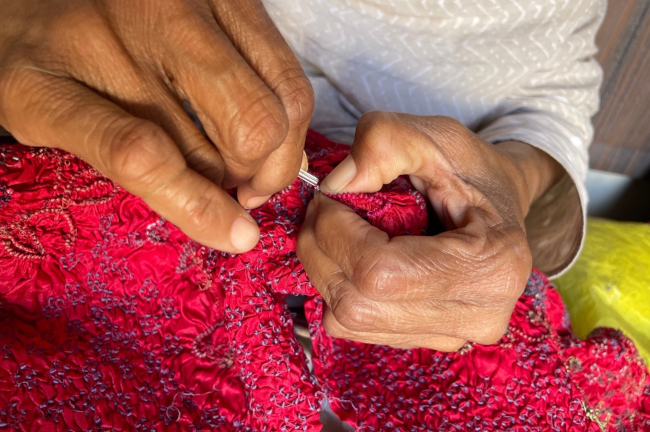
括り作業後は、生地を染色工房に戻し、染色する。湯洗いし、きれいにした後に、最も明るい色(通常は黄色)から順に染めていく。一色染めるごとに、括りを担当する女性たちに生地を戻して次に防染する箇所を追加で括ってもらう。このやりとりを必要な色の数だけくり返す。染め作業は、作業中に結び目がほつれないよう細心の注意を払って行われる。
After the tying process, the fabric is returned to the dyeing workshop for dyeing. After washing and cleaning the cloth, it starts dyeing with the lightest color (usually yellow). After each color is dyed, the women in charge will put together the fabric and additional areas are tied for the next resist-dyeing. This step is repeated as many times as necessary to dye many colors. The dyeing process is done with great care to ensure that the knots do not unravel during the process.
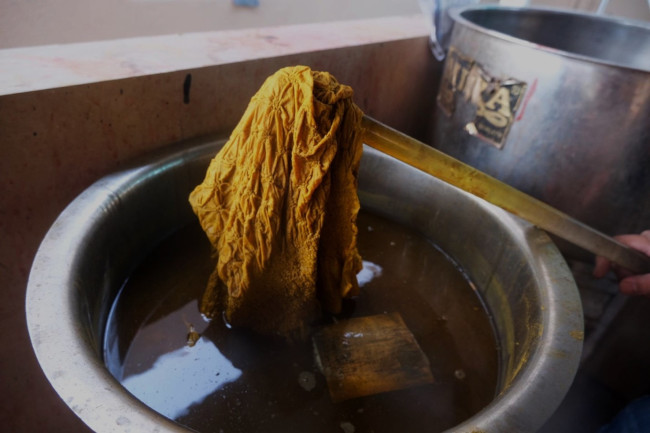
染め上がった生地を乾かしたあとは、デリ(括りの糸)をとるために、対角線上の左右の端から、左上と右下、右上と左下というように、多くの場合、ふたりで同時に引っ張る。生地にテンションがかかったところからその結び目が開き、防染されていたドットの部分が次々と覗く。引っ張りながら、生地についたデリも回収することが多いが、“本物”の証としてあえてそれをを残し、模様の確認用に一部分だけ伸ばした状態で販売されることもある。
After the dyed fabric has dried, two people often pull it at the same time to remove the tied thread, starting from the left and right edges on a diagonal line, working from the top left and bottom right, and the top right and bottom left. The knots are opened when a tension is applied to the fabric, revealing one after another the undyed dots. While pulling the fabric, the deli is usually collected and removed, but it is sometimes left on purpose as a proof of authenticity and is sometimes sold partially stretched to confirm the patterns.
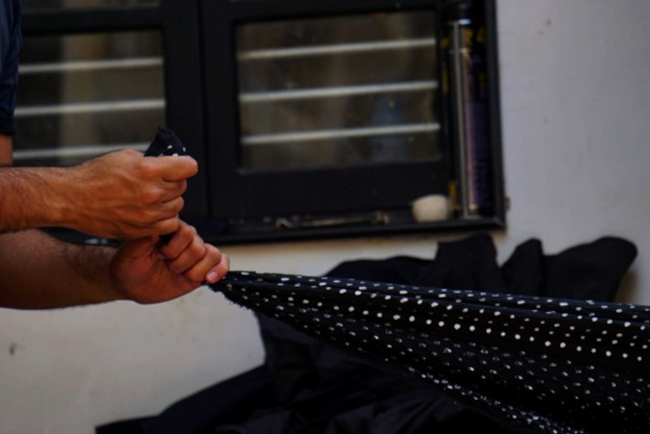
SIDRクラフト About SIDR Craft
バンダニ・カトリーの家に生まれたアブドゥラとアブドゥルジャバールの兄弟は、一度絶えた伝統的なバンダニを復元するために、叔父や女性たちにバンダニを学び、1992年に工房を設立しました。以来、積極的に古典柄の復元と板締め(clamp dye) などの新しい表現に取り組んでいます。バンダニは、女性の括り仕事なしでは成り立たず、現在8つの村の200名以上の女性たちと仕事に取り組んでいます。コロナ渦中に、伝統染料および新しい天然染料の専用スタジオも新設し、研究と実践を行っています。
Born in Bandhani Khatri family, Abdullah and Abduljabbar had learnt about Bandhani from their uncle and family ladies and have established studio in 1992. Since then, they proactively have engaged in reviving classic designs also explored new expressions using techniques of clamp dyes etc. As Bandhani, it never has been made without ladies who can do tying, they are working with more than 200 ladies from 8 villages in Kutch. During Covid time, they set up a new studio dedicate to traditional dye as well as new natural dye materials, to study and experiment.
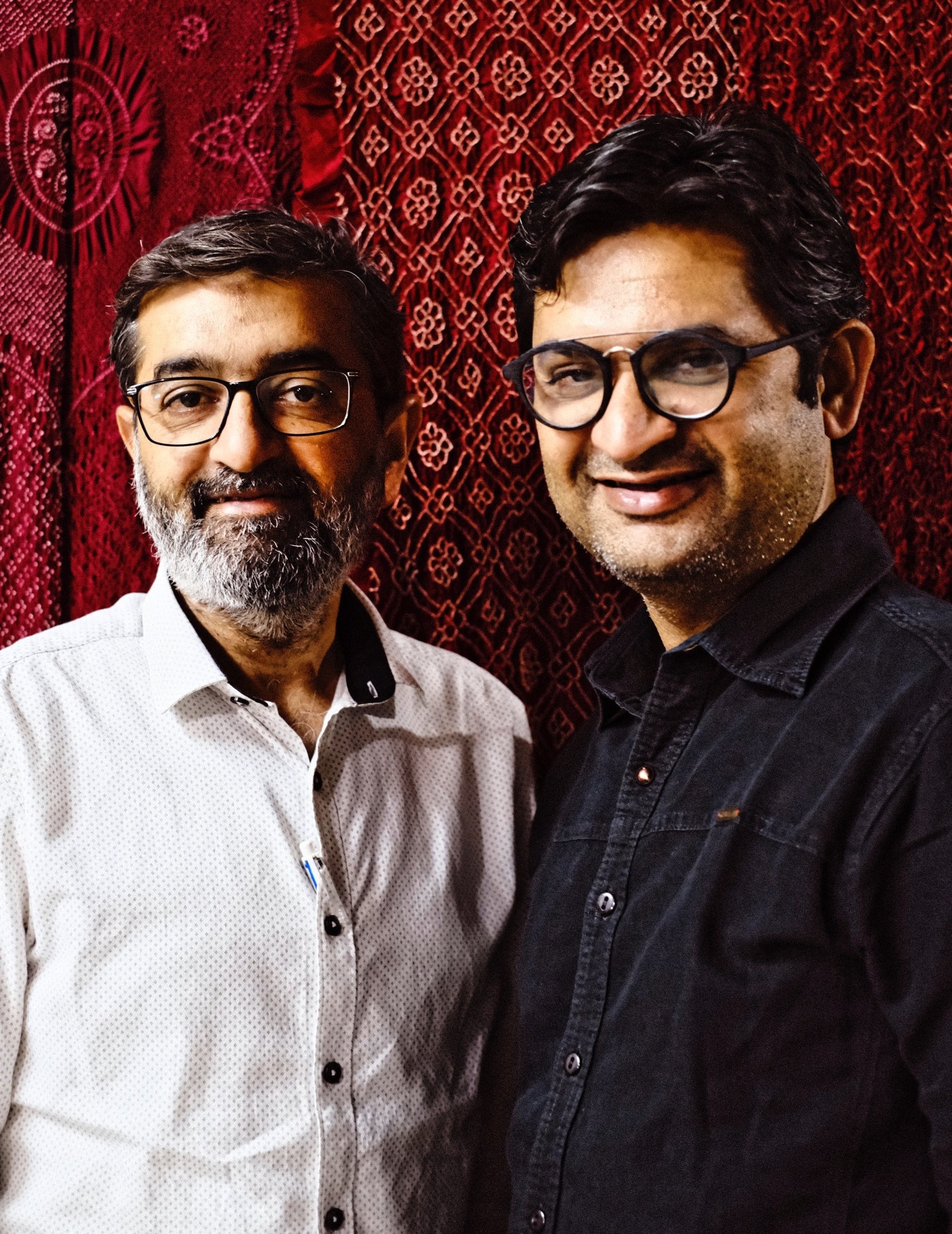
Elder brother Abdullah in the left. Younger brother Abduljabbar in the right. Photo by Yayoi Arimoto 2019
参考文献 References
- 布がつくる社会関係―インド絞り染め布とムスリム職人, 金谷美和, 思文閣出版, 2007
(Construction of Social Relationships through Cloths: Bandhani and Muslim Craftpersons, Miwa Kanetani, Shibunkaku Shuppan, 2007) - Tie-dyed Textiles of India Tradition and Trade, Veronica Murphy and Resemary Crill, Victoria and Albert Museum, 1991
- インドの伝統染織:スイス・バーゼル民族学博物館蔵, マリー・ルィーズ=ナブホルツ-カルタショフ, 紫紅社, 1986
(Japanese edition of Golden Sprays and Scarlet Flowers Traditional Indian Textiles, Marie-Louise Nabholz, Shikonsha, 1986) - Indian Tie-Died Fabrics, Alfred Bühler, Eberhard Fischer and Marie-Louise Nabholz, CALICO Museum of Textiles India, 1983
調査編集協力者 Contributor
- フィールド調査協力:アブドゥラー・カトリー(SIDRクラフト)、アブドゥラジャバール・カトリー(SIDRクラフト)、アブドゥルアジーズ・カトリー(カミール)、ヤコブ・フサイン・ポターイ、ヴァンカル・シャムジー・ヴィシュラム
- 資料調査協力:内村航、笠井良子、グエン・チャン・シミン
- 翻訳協力:グエン・チャン・シミン
- 編集協力:笠井良子
- 調査企画編集:小林史恵
(敬称略)
- Field Research Support: Abdullah Khatri (SIDRcraft), Abduljabbar Khatri (SIDRcraft), Abdulaziz Khatri (Khamir), Yakob Husain Pothai, Vankar Shamji Vishram
- Documentation Research Support: Kou Uchimura, Yoshiko Kasai, Gwen Chan Si Min
- Translation Support: Gwen Chan Si Min
- Editting Suport: Yoshiko Kasai
- Research, Planing & Editting: Fumie Kobayashi
